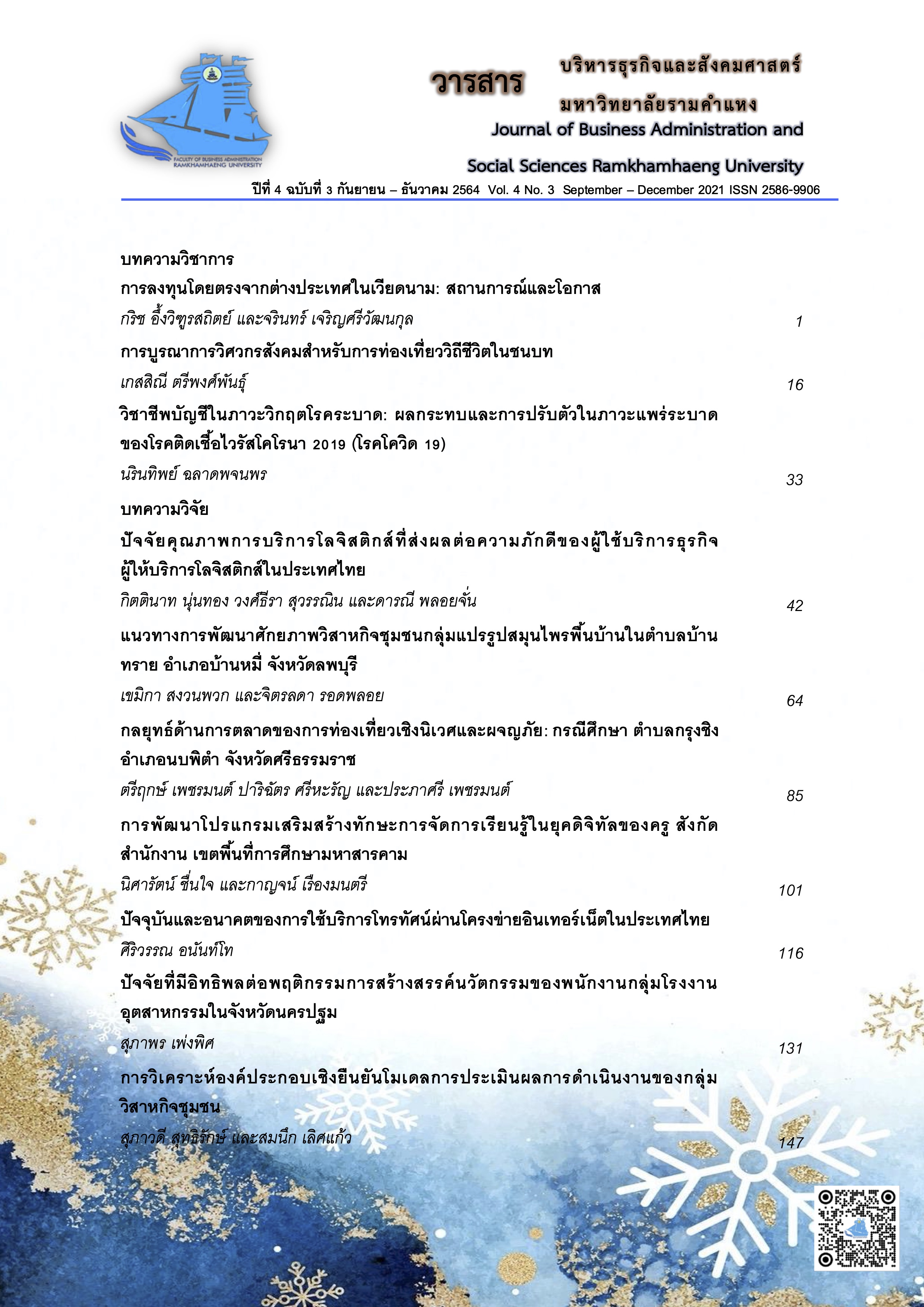Foreign Direct Investment in Vietnam: Situations and Opportunities
Main Article Content
Abstract
Article Details

This work is licensed under a Creative Commons Attribution-NonCommercial-NoDerivatives 4.0 International License.
เนื้อหาและข้อมูลในบทความที่ลงตีพิมพ์ในวารสารบริหารธุรกิจและสังคมศาสตร์ มหาวิทยาลัยรามคำแหง ถือเป็นข้อคิดเห็นและความรับผิดชอบของผู้เขียนบทความโดยตรง ซึ่งกองบรรณาธิการไม่จำเป็นต้องเห็นด้วย หรือร่วมรับผิดชอบใดๆ
บทความ ข้อมูล เนื้อหา รูปภาพ ฯลฯ ที่ได้รับการตีพิมพ์ในวารสารบริหารธุรกิจและสังคมศาสตร์ มหาวิทยาลัยรามคำแหง ถือเป็นลิขสิทธิ์ของวารสารบริหารธุรกิจและสังคมศาสตร์ มหาวิทยาลัยรามคำแหง หากบุคคลหรือหน่วยงานใดต้องการนำบทความทั้งหมดหรือส่วนหนึ่งส่วนใดไปเผยแพร่ต่อ หรือเพื่อกระทำการใดๆ จะต้องได้รับอนุญาตเป็นลายลักษณ์อักษรจากวารสารบริหารธุรกิจและสังคมศาสตร์ มหาวิทยาลัยรามคำแหง ก่อนเท่านั้น
References
กรมประชาสัมพันธ์ศูนย์ข้อมูลข่าวสารอาเซียน. (2558). ประวัติศาสตร์เวียดนาม.สืบค้นจาก http://www.aseanthai.net/ewt_news.php?nid=4038&filename=index
กระทรวงพาณิชย์, สำนักงานส่งเสริมการค้าในต่างประเทศ ณ กรุงฮานอย. (2563). ญี่ปุ่นส่งเสริมให้บริษัท 15 ราย ย้ายโรงงานมาที่เวียดนาม. สืบค้นจาก https://www.ditp.go.th/contents_attach/637305/637305.pdf
กระทรวงพาณิชย์, สำนักงานส่งเสริมการค้าในต่างประเทศ ณ กรุงฮานอย. (2563). รายงานสถานการณ์เศรษฐกิจระหว่างประเทศ: สาธารณรัฐสังคมนิยมเวียดนาม ประจำเดือนพฤศจิกายน 2563. สืบค้น จาก https://www.ditp.go.th/contents_attach/670604/670604.pdf
กระทรวงพาณิชย์, สำนักงานส่งเสริมการค้าในต่างประเทศ ณ กรุงฮานอย. (2564). รายงานสถานการณ์เศรษฐกิจระหว่างประเทศ: สาธารณรัฐสังคมนิยมเวียดนาม ประจำเดือน ธันวาคม 2563. สืบค้น จาก https://www.ditp.go.th/contents_attach/690887/690887.pdf
กระทรวงพาณิชย์, สำนักงานส่งเสริมการค้าในต่างประเทศ ณ นครโฮจิมินห์. (2564). รายงานสถานการณ์สถานการณ์การลงทุนของเวียดนามในเดือนธันวาคม 2563. สืบค้นจาก https://www.ditp.go.th/contents_attach/690887/690887.pdf
กระทรวงพาณิชย์, กรมส่งเสริมการค้าระหว่างประเทศ. (2561). คู่มือโอกาสและทิศทางการลงทุนในเวียดนาม. สืบค้นจาก https://www.ditp.go.th/ditp_web61/article_sub_view.php?filename=
contents_attach/540248/540248.pdf&title=540248&cate=1002&d=0
ฟันนี่เอส. (2564, 12 สิงหาคม). เวียดนามผงาด. ไทยรัฐ, น.8.
ธนวัฒน์ พนิตพงศ์ศรี และณัฐพล จรูญพิพัฒน์กุล.(2563).เจาะลึกความสามารถในการแข่งขันของเวียดนาม [FAQ Focused and Quick, Issme178]. สืบค้นจาก https://www.bot.or.th/ Thai/MonetaryPolicy/ArticleAndResearch/Pages/FAQ178.aspx
ธนาคารแห่งประเทศไทย,ฝ่ายความร่วมมือระหว่างประเทศ. (2564). สรุปภาวะเศรษฐกิจ-การเงิน 2563-2564. สืบค้นจาก https://www.bots.or.th/
สำนักข่าว Infoquest. (2563). เวียดนามปรับสถานการณ์ GDP ปี 2564 เป็น 6.5% แม้เผชิญโควิด-ภัย ธรรมชาติ, สืบค้นจาก https://www.infoquest.co.th/2020/55821
สำนักงานส่งเสริมการค้าในต่างประเทศ ณ นครโฮจิมินห์. (2564). การเติบโตของตลาดค้าปลีกของเวียดนาม [ข่าวเด่นประจำสัปดาห์จาก สคต. ณ นครโฮจิมินห์ ระหว่างวันที่ 13-19 มกราคม 2564].สืบค้นจาก https://www.ditp.go.th/contents_ attach/709392 /709392.pdf
สำนักงานส่งเสริมการค้าในต่างประเทศ นครโฮจิมินห์, ศูนย์พัฒนาการค้าและธุรกิจในอาเซียน. (ม.ป.ป.).ข้อมูลการลงทุนในเวียดนาม. สืบค้นจาก https://ditp.go.th/contents_attach/92832/92832.pdf
หอการค้าและสภาหอการค้าแห่งประเทศไทย. (2554). คู่มือการค้าการลงทุนสาธารณรัฐสังคมนิยมเวียดนาม. สืบค้นจาก https://sme.go.th/
Jiratikarnsakul, V. (2020). CLMVI market and investment opportunities: Vietnam focus. Retrieved from https://www.wha-industrialestate.com/en/management-structure/
SCB Economic Intelligence Center. (2019). CLMV monitor Q1 2019. Retrieved from https://www.scbeic.com/th/detail/file/product/5845/fac13lx2dv/CLMV_Q1_2019_TH_20190313_External_Final.pdf
Vietnam News Agency. (2020, December 21). Nearly 47 percent of Japanese Firms in Vietnam plan Expansion. Retrieved from https://en.vietnamplus.vn/nearly-47-percent-of-japanese-firms-in-vietnam-plan-expansion/196113.vnp


